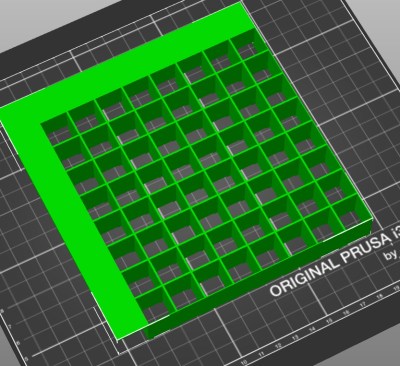Despite all the incredible advancements made in video game technology over the last few decades, the 8-bit classics never seem to go out of style. Even if you weren’t old enough to experience these games when they were new, it’s impossible not to be impressed by what the early video game pioneers were able to do with such meager hardware. They’re a reminder of what can be accomplished with dedication and technical mastery.

If you’d like to put a little retro inspiration on your desk, take a look at this fantastic 16 x 16 LED matrix put together by [Josh Gerdes]. While it’s obviously not the only thing you could use it for, the display certainly seems particularly adept at showing old school video game sprites in all their pixelated glory. There’s something about the internal 3D printed grid that gives the sprites a three dimensional look, while the diffused glow reminds us of nights spent hunched over a flickering CRT.
The best part might be how easy it is to put one of these together for yourself. You’ve probably got most of what you need in the parts bin; essentially it’s just a WS2812B strip long enough to liberate 256 LEDs from and a microcontroller to drive them. [Josh] used an Arduino Nano, but anything compatible with the FastLED library would be a drop-in replacement. You’ll also need a 3D printer to run off the grid, and something to put the whole thing into. The 12×12 shadowbox used here looks great, but we imagine clever folks such as yourselves could make do with whatever might be laying around if you can’t nip off to the arts and crafts store right now.
Beyond looking great, this project is a fantastic reminder of how incredibly handy WS2812 LEDs really are. Whether you’re recreating iconic game sprites or fashioning your own light-up sunglasses, it’s hard to imagine how we managed before these little wonders hit the scene.














That’s nice!
I’d like to see them scroll into frame, pause, and then scroll out in their native direction though.
Well done. I wonder if some of the old sprites were 32 x 32 pixels.
I would have used and old LCD monitor to house it.
https://vgdensetsu.tumblr.com/post/179656817318/designing-2d-graphics-in-the-japanese-industry
Here’s a really interesting article about how artists very deliberately used CRT quirks and artifacts to add detail to sprite graphics in a way that didn’t take up any compute resources or increase the necessary resolution. It’s pretty amazing. Look at the side-by-side comparisons, and all the shading and apparent extra color palette the CRT adds. It’s night and day. But yeah, the true native display for sprites is always gonna be CRT… but it would be pretty interesting to investigate some mechanism for replicating these intentional artifacts in an LED matrix/modern flat-panel display. I’m sure you could make some simulation of the scan-line fade and horizontal smear that they compensated for.
One of the quirks was CRT pixels aren’t squares but rectangles! :)
Great article! Thanks for sharing
You lose all credibility when you say: “Using the hexadecimal system contributed to save ROM space”. (from the article qwert linked to).
Can anyone explain why each “pixel” isn’t solid but has a glow on the upper right ?
Because the LEDs aren’t sufficiently diffused. This is something that probably looks worse in camera than in person.
I like it, a true retro necessity. I feel a desktop game of life coming up.